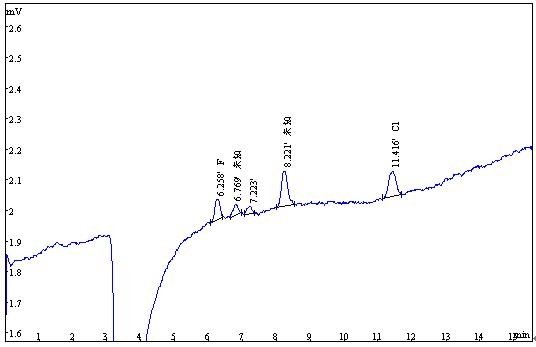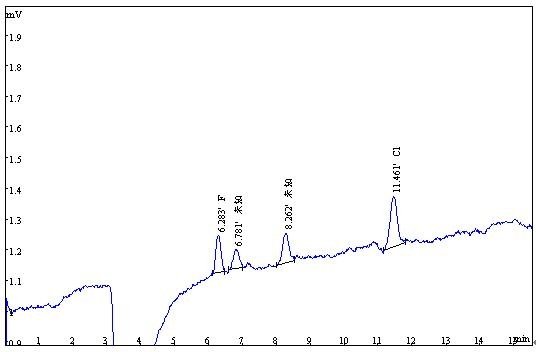For electronic products, nuclear power and other industries, the purity of water has an extremely important position. Trace ions will make the purity of the product is not up to standard scrap, or the corrosion of the motor surface. Ion chromatography is a fast and sensitive method for the determination of anions and cations. It has become an essential instrument for fine product manufacturing. It can be used to measure mg / L ions in direct injection. Concentrated by enrichment, can be measured to ng / L level. In this paper, the trace of F- and Cl- in pure water was analyzed by PIC-10 ion chromatograph (equipped with a five-pole conductivity detector) produced by Qingdao Pu Ren Instrument Co., Ltd. to optimize the chromatographic conditions and direct injection The method can be sensitive to the determination of several mg / LF- and Cl-, resulting in better results.
Chromatographic conditions:
Ion chromatograph: PIC-10 type, Qingdao Pu Ren Instrument Co., Ltd. (with a five-pole conductivity detector)
Column: Shodex 52 4E (4.0 * 250mm)
Eluent: Na2CO3 + NaOH
Flow rate: 0.7 mL / min
Detector: Suppresses conductivity detection
Injection volume: 100uL
Column and detector temperature: 36 ° C
Selection and optimization of chromatographic conditions:
For the sensitive determination of mg / L grade ions, an efficient ion exchange column is required. The Shodex 52 4E (4.0 * 250mm) column is used in this paper. The column number of SO42- ions is up to 14000 / m, Trace ion of choice. But the elution of the column recommended for the 3.6mM Na2CO3, the leaching of ions only negative divalent CO32-; due to the carbonate eluent in the inhibition of conductivity detection in the presence of water negative peak, the weak retention of F- The concentration of CO32- in the eluent does not have a significant effect on the retention time and signal-to-noise ratio of the negative F-, Cl-, and thus reduce the concentration of CO32- in the eluent And add OH- as a negative monovalent elution ion. The method of large volume direct injection is a common method for the determination of trace ions, which eliminates the need for enrichment and enrichment.
4mm diameter column, the injection volume is generally not more than 200mL. By constantly trying, the authors found that the water peak did not interfere with F-quantification at 100 mL injection volume, and F- and Cl- were able to achieve a higher signal-to-noise ratio, thus using a 100 mL sample volume.
Pre-experimental preparation
Use a water with a resistivity greater than 18.2 megohm to clean the vials for 3-5 times and fill the vials, tighten the cap and soak for 4 hours. F-, Cl-solution, mg / L grade F-, Cl- is ready for use and is used within 6 hours after configuration.
Experimental results
First measure 18.2 megohm of deionized water blank, the chromatogram is shown below.

As can be seen from the chromatogram, deionized water in the 8.3min and 11.5min detection of two substances, of which 11.5min chromatographic peaks and Cl-retention time consistent, indicating that there is a trace of deionized water Cl- (signal to noise ratio For 4.6). F- (retention time is 6.2 min) is not detected.
Use a vial to prepare the various solutions before using deionized water for repeated cleaning and soaking for 4 hours. After soaking for 4 hours, the blank value of the solution was determined and the chromatogram was as follows.

As can be seen from the chromatogram, deionized water in the immersion capacity bottle 4 hours later, there are three substances were detected. The signal-to-noise ratio of Cl- in this sample is 5.4, and F- is not detected. After measuring the blank of deionized water and volumetric flask, a solution containing 2.5 mg / LF-, Cl- was injected into an ion chromatograph to give the following chromatogram.

As can be seen from the chromatogram, F-, Cl- are clearly detected in the chromatogram, in addition to three unknown components. The signal-to-noise ratios of F- and Cl- are 3.4 and 4.0, respectively (Cl-not blank).
A solution containing 5.0 mg / LF-, Cl- was injected into an ion chromatograph to give the following chromatograms.

As can be seen from the chromatogram, F-, Cl- are clearly detected in the chromatogram, in addition to two unknown components. The signal-to-noise ratios of F- and Cl- are 6.0 and 8.0, respectively (Cl-not blank). Conclusion The use of domestic PIC ion chromatography and five-pole conductivity detector, can be sensitive to the determination of mg / LF- and Cl-. Deionized water and volumetric flask blank samples show that F-in the chromatographic conditions there is no interference, can be sensitive and accurate determination. There is a trace of Cl- in the blank sample, and the signal-to-noise ratio is greater than three, so that several mg / LCl- in the actual sample can only be sensitive and can not be accurately determined. The use of more pure water as a solvent, when the deionized water and volumetric bottles and other blank samples Cl - less than three times the signal to noise ratio can accurately determine the trace of Cl-.



